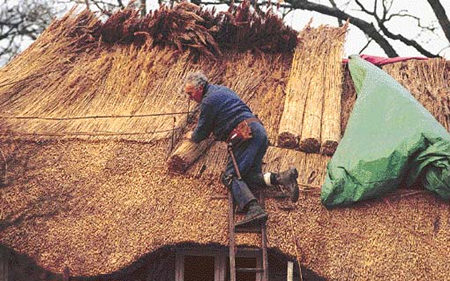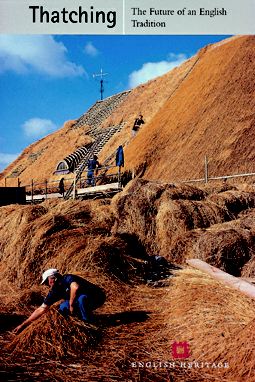Thatch in the 21st Century
Clive Fewins
Thatch is enjoying a revival in England. But there are increasing concerns at English Heritage about the level of imports of water reed which it fears will lead to the erosion of some of our thatching traditions. Clive Fewins reports…

Thatch - Henry James said it represented
'unmitigated England' - is arguably the most attractive
and almost certainly the oldest of the roofing materials still in
regular use in this country. To expatriots and others the world over,
the snug look of a cosy collection of thatched homes gathered round
the village church still presents a vivid image of rural England.
But thatch is far more than this. It is the archetypal roofing material.
In Britain, archaeologists have found evidence of buildings with straw
roof coverings dating back to 500bc, and today there are known to
be at least 30,000 thatched buildings in England alone, some 24,000
of which are listed. Far from being a dying craft, thatch is thriving.
At a major conference organised by English Heritage in London in November
1999 the then Chairman, Sir Jocelyn Stevens, stated that while thatching
is undergoing a resurgence, with many new thatched homes being built
in the countryside, the thatching industry itself was 'far from
a scene of bucolic harmony', with many conflicts and disagreements
between thatchers and conservationists. Despite the fact that England
is still regarded as having a far more diverse and healthy thatching
tradition than any other European country, there were genuine fears
within English Heritage for the future of that tradition.
MATERIALS
Over the years all sorts of materials - oats, marsh reeds, broom,
heather and bracken, and various grasses - have been used for thatching.
Today only three materials are widely used in England; long straw,
combed wheat reed and water reed.
Long straw and combed wheat reed are two methods that use the same
material - wheat straw - only in a different way. Long straw has a
distinctive 'poured on' look that gives it a unique exterior appearance.
This is because it has gone through a different threshing process
from which it emerges bruised and bent. When on the roof it does not
compact like the other two main forms of thatch and it retains its
'shaggy' look throughout its life.
Combed wheat reed has a much neater, trimmed look. It is seen widely
in the south and west of England and is applied by a completely different
method. It is dressed, and knocked into shape. Long straw, by contrast,
is placed in position, then raked.
Water reed - sometimes referred to as Norfolk reed (though much of
it comes in from Eastern Europe and Turkey nowadays) is a completely
different material. Unlike the straw used for the other two forms
of thatching it was never an agricultural by-product. Water reed is
a true reed and is regarded as a superior material. Traditionally
it costs slightly more than the other two materials.
REGIONAL
STYLES
The appearance of a roof is affected not only by the choice of material,
but also in the detailing of eaves, dormers, ridges and surface decoration
in particular. Distinct regional styles of thatching are apparent,
and variations may occur from one village to another, particularly
where one style has been adopted by local thatchers and handed down
from one generation to the next.
However, do not expect to find any one style in any area of the country.
You will find all the styles used throughout the principal thatched
areas. Nevertheless, the regional variations are striking. For example,
in Devon and other areas of the South-West, where the 'tea-cosy' look
is renowned, cottages with thick cob walls one storey high are able
to support only light roofs, with heavily overhung dormers that attempt
to let daylight into the rooms behind. These cottages characteristically
have roofs of combed wheat reed, piled in many layers, the ones underneath
frequently being several hundred years old.
Water reed roofs, also found in Devon but more widespread in Dorset
and parts of the Home Counties, have a stiffer, more assertive look
and often sport a sharply-defined incised patterned ridge. Water reed
is coarser in texture and stiffer in appearance than combed wheat
reed, which has an altogether softer and smoother look.
Long straw roofs are to be seen in many
parts of the South-East, and in Hampshire and Northamptonshire in
particular. However, it is in East Anglia, and the characteristically
steep-pitched roofs of cottages in Essex, Suffolk and Norfolk that
long straw really comes into its own.
In East Anglia long straw thatchers will cite examples of roofs constructed
from the material that they say have lasted as long as 60 years. It
is claimed that the drying winds and the good air circulation found
in the east of England are one reason for this. Another reason is
the steep roof pitches common in their part of the country. In Norfolk
and Suffolk, as well as in parts of Essex, pitches of 60 degrees are
not unusual.
You can usually tell a long straw thatch because the eaves and barges
are nearly always finished with 'liggers' - criss-crossed lengths
of split hazel or willow - used on the surface. In other forms of
thatch these are generally applied to the ridge only.
Ridges are constructed in 'plain' (flush) and 'blocked' (raised) styles
and also in'wrap-over' and 'butts-up' (with the ends pushed together).
Wrapover ridges - particularly if they are raised with an ornamental
criss-cross pattern - are inevitably more expensive because there
is more labour and material involved.
CHANGING
STYLES
The need to replace thatch at regular intervals means that the appearance
of thatched roofs can change dramatically, affecting the character
of each building and, in time, the character of a locality. It has
been said that no other element of traditional architecture is prone
to such radical alteration.
Eight years ago there was a celebrated case in Northamptonshire in
which a man who had rethatched his listed cottage with a block-cut
patterned ridge that was considered by the local authority to be out
of keeping with the vernacular, won his appeal against removing and
replacing the ridge.
The affair caused a good deal of comment in thatching circles, and
highlighted English Heritage's concern that we are in danger of losing
aspects of our native thatching tradition. In particular the rising
level of imported water reed and the greater mobility of thatchers
is believed to be causing a diminution of distinct styles that characterise
different parts of the country.
This issue has been made more complex by the recent arrival of a new form of straw used for both combed wheat reed and long straw thatching. It is Triticale, a cross between wheat and rye. It has the advantage of being less susceptible to some of the climatic problems that have caused the poor harvests of other forms of wheat straw in the past two seasons. Many thatchers are now using it as a substitute for combed wheat reed. On the roof it is indistinguishable from the latter.
 |
| A recent booklet on thatching produced by English Heritage |
THE
GREAT DEBATE
English Heritage called the first national conference on thatching
in London late 1999. Entitled Thatching, the Future of an English
Tradition, the day-long event, at which the keynote speech was
delivered by HRH The Prince of Wales, was also used to launch a 20
page illustrated booklet Thatch and Thatching, to serve as a guide
on conservation issues to professionals and local authority employees
involved with thatching.
The conference was not without its controversial moments.
With the aid of slides several speakers emphasised that when thatching
materials change, so too do the architectural details of the roofs
they cover. At eaves, verges, ridges and chimneys, around dormers,
across valleys and hips, the visual appearance of individual buildings
is often drastically affected. When this process takes place with
two or three properties in a historic group in a village the change
to the character of the local area becomes even more dramatic.
Time and again however English Heritage speakers emphasised that they
felt that the tradition of straw thatching in England was under attack
by elements within the thatching industry who regarded straw as an
inferior material and, in the words of Sir Jocelyn Stevens, believe
that 'the availability and technological superiority attributed
to water reed qualifies it for use in all cases'.
English Heritage speakers acknowledged that with poor harvests of
thatching straw in recent years many householders are turning to the
traditionally more expensive water reed, principally because it has
a reputation for longevity.
Several speakers favoured the rights of homeowners to use the material
of their own choice on their roofs, particularly as thatch is perceived
as being an expensive form of roofing that needs more maintenance
and more frequent replacement than other forms of roofing.
Many thatchers take the view that it is important to preserve the
historic basecoat, as thatching materials and styles change in what
is basically a dynamic, evolving craft. Local styles, it was pointed
out, had evolved over many hundreds of years at the hands of dynasties
of craftsmen. Almost certainly the appearance of thatch applied today
in most areas of the country would look very different from the thatched
roofs to be seen in medieval times.
Other thatchers contended that a good craftsman will choose the best
available material for his client. In some areas this would inevitably
mean replacing inferior materials with more durable ones. On listed
buildings it was accepted that this would sometimes lead to conflicts
between thatchers and conservation officers.
A strongly worded speech from Roger Scanlan, chairman of the National
Council of Master Thatchers Associations accused English Heritage
of taking 'no constructive interest in thatch for the past 25
years' and of finally creating a hurriedly-produced document
that contained 'errors and technical failings'.
The core of Roger Scanlan's speech was that thatching should be left
to thatchers. He said that he agreed with the English Heritage view
that moving from long straw to water reed in areas where historically
buildings were thatched with the former was a bad practice that changed
the character and appearance and also destroyed the basecoats of many
historic properties. However, he believed that this practice had now
largely halted and that in the current climate there was greater consultation
between conservationists and thatchers to protect historic thatched
roofs.
Other speakers urged that there should be greater consensus on the
scope and standards of conservation practice within the thatching
industry.
The argument will doubtless continue. It is an area in which there
is never likely to be a true meeting of minds between any two thatchers,
let alone the principal thatchers' organisations and English Heritage.
Fortunately, it cannot be denied that the great joy of thatch is that
in the hands of a good craftsman it takes on a wonderful undulating,
fluid quality and can achieve all sorts of effects that are impossible
with other roofing materials.
Recommended Reading
- Thatch: Thatching in England Vol 1 1790-1940, Vol 2 1940-1990, English Heritage Research Transactions, James & James/English Heritage, 2000



